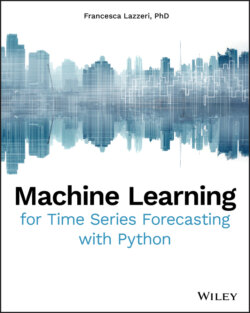Читать книгу Machine Learning for Time Series Forecasting with Python - Francesca Lazzeri - Страница 5
CHAPTER 1 Overview of Time Series Forecasting
ОглавлениеTime series is a type of data that measures how things change over time. In a time series data set, the time column does not represent a variable per se: it is actually a primary structure that you can use to order your data set. This primary temporal structure makes time series problems more challenging as data scientists need to apply specific data preprocessing and feature engineering techniques to handle time series data.
However, it also represents a source of additional knowledge that data scientists can use to their advantage: you will learn how to leverage this temporal information to extrapolate insights from your time series data, like trends and seasonality information, to make your time series easier to model and to use it for future strategy and planning operations in several industries. From finance to manufacturing and health care, time series forecasting has always played a major role in unlocking business insights with respect to time.
Following are some examples of problems that time series forecasting can help you solve:
What are the expected sales volumes of thousands of food groups in different grocery stores next quarter?
What are the resale values of vehicles after leasing them out for three years?
What are passenger numbers for each major international airline route and for each class of passenger?
What is the future electricity load in an energy supply chain infrastructure, so that suppliers can ensure efficiency and prevent energy waste and theft?
The plot in Figure 1.1 illustrates an example of time series forecasting applied to the energy load use case.
Figure 1.1: Example of time series forecasting applied to the energy load use case
This first chapter of the book is dedicated to the conceptual introduction—with some practical examples—of time series, where you can learn the essential aspects of time series representations, modeling, and forecasting.
Specifically, we will discuss the following:
Flavors of Machine Learning for Time Series Forecasting – In this section, you will learn a few standard definitions of important concepts, such as time series, time series analysis, and time series forecasting, and discover why time series forecasting is a fundamental cross-industry research area.
Supervised Learning for Time Series Forecasting – Why would you want to reframe a time series forecasting problem as a supervised learning problem? In this section you will learn how to reshape your forecasting scenario as a supervised learning problem and, as a consequence, get access to a large portfolio of linear and nonlinear machine learning algorithms.
Python for Time Series Forecasting – In this section we will look at different Python libraries for time series data and how libraries such as pandas, statsmodels, and scikit-learn can help you with data handling, time series modeling, and machine learning, respectively.
Experimental Setup for Time Series Forecasting – This section will provide you general advice for setting up your Python environment for time series forecasting.
Let's get started and learn some important elements that we must consider when describing and modeling a time series.
